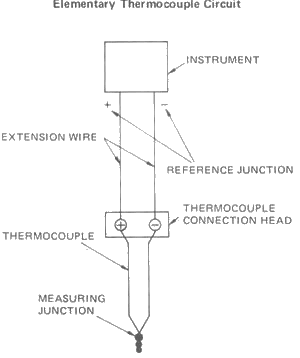|
THERMOCOUPLE
TYPES
A thermocouple is
a temperature sensor. In its most common form it consists of
two wires of different composition. The two wires are joined
together at two points which have different temperatures.

One of points is at
a known temperature. This point is the reference junction.
The reference junction is also often, but less preferably, called
the "cold" junction. The temperature of the reference
junction is held constant, or its variation is electrically compensated
for in the associated measuring instrumentation.
The second junction
is the measuring junction. the measuring junction is also often,
but less preferably, called the "hot" junction. The
measuring junction is often at an unknown temperature at which control
is required.
A thermocouple is
useful for temperature sensing because a measurable electrical signal
is produced. the signal is a function of the difference in temperature
between the measuring and difference in temperature between the measuring
and reference junctions. Numerous combinations of dissimilar
metals are used as thermocouples. Some of these combinations
have become relatively standard and widely accepted for a large segment
of industrial temperature measurements. A specific combination
is generally referred to as a type, or calibration. Most of
the common calibrations have American National Standards Institute
(ANSI) letter codes. These letter codes were
originally established
by the Instrument Society of America.
The common calibrations
are identified in Table 1 with application data for each.
The recommended temperature
range is that or which limits of error are established. No guarantee
is made, or implied, regarding the successful use of any of the above
calibrations in their recommended range.
Use of a thermocouple
outside its recommended temperature range may adversely affect its
reliability over its recommended range.
Numerous factors combine
to determine the successful application of a particular thermocouple.
Some of these factors are
|
temperature, cycling,
chemical exposure, degree of protection provided, and mechanical abuse
given to the thermocouple.
The above mentioned
thermocouple calibrations are maintained by proper manufacturing control
of each of the thermo elements. Elemental constituents are controlled
to a high degree. Homogeneity must be maintained, and all wire
must be properly annealed.
EXTENSION WIRE
To reduce costs when
long thermocouple lengths are required, especially with the noble
metal calibrations, extension lead wire extends the reference junction
of the thermocouple to the instrument. For the base metal calibrations
the extension wire is nominally of the same composition as the thermocouple
grade material. Control in manufacturing is not to to the same
degree as thermocouple grade wire. With lessening rigidity of
manufacturing control considerable expense can be saved. There
is a limitation on the maximum temperature to which the junction of
extension wire and thermocouple wire should be exposed. For
the base metal calibration except type T the maximum temperature is
204oC. For type T it is 93oC.
Nobel metal types
R, S, B, Platinel, the tungsten-rhenium calibrations are used with
"compensating alternate" extension wire, which means the
extension wire is made of material differing in composition from the
thermocouple wire, but at temperatures encountered at the thermocouple
extension junction, has corresponding Temperature - EMF characteristics.
The maximum temperature limitations for the thermocouple extension
junction for calibration types.R, S, B, and Platinel is 204oC.
For Tungsten/Tungsten-26% Rhenium (W/W-26% Re), Tungsten - 3% Rhenium/Tungsten-25%
Rhenium (W-3% Re/W-25% Re) IT 260Oc. For W-5% Re/W-26%
Re IT 871Oc. The reason for the limitation is that
the thermocouple and extension wire junction is one of the materials
of differing composition, and hence another thermocouple.
Whenever extension
wire is used, precautions should be taken to insure a uniform temperature
exists across both thermocouple and extension wire junctions.
If there is sufficient temperature gradient between the temperature
and extension wire junctions and the terminals at the instrument when
copper extension wire is used. appreciable error may be produced.
Thermocouple extension
wires should be installed in conduit whenever possible and the conduit
should be well grounded. Never run other electrical wires in
the same conduit with extension wires. Keep the extension wires
at least a foot away from any a-c line.
LIMITS OF ERROR
Mention has been made
to "limits of error" applicable
to thermocouple calibrations. The limits of error pertains
to the temperature deviation tolerance acceptable for the calibration.
Limits of error are stated either in degrees or as a percentage of
the temperature measured. Limits of error of the extension wire
for the Tungsten-Rhenium calibration are presently given in millivolts.
Two levels of limits of error are published for the common calibrations;
Standard and Special. Special Limits of Error are generally
one-half the magnitude of Standard Limits of Error except for calibration
type E. Limits of error are additive. For example, when
a thermocouple-extension wire junction for type J calibration exists
the standard limits of error for the thermocouple wire below 277oC
are ±2.2oC and for the extension wire below 205oC
are ± 2.2oC. Combined standard limits of error are 4.4oC
and deviation from NBS Temperature-EMF tables for this combination
within standard limits of error could be from 0 to 4.4oC.
Limits of error are only stated for common gauge sizes, and do not
consider system errors.
|

